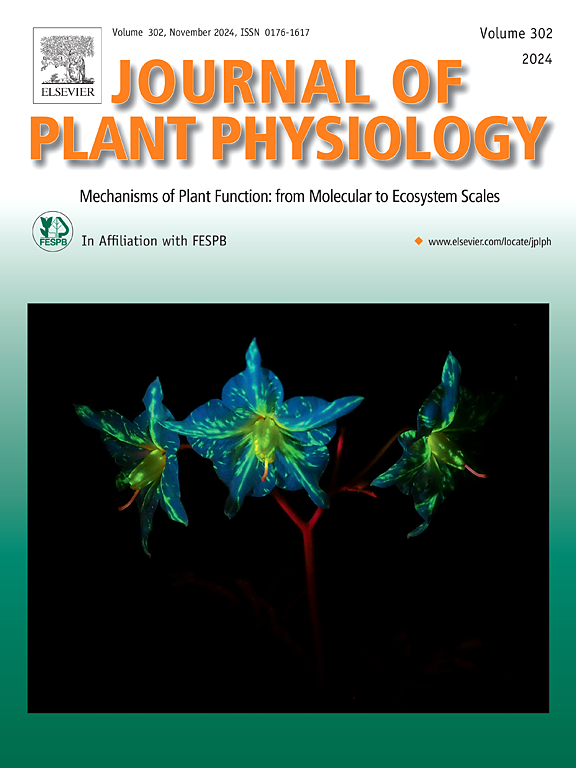Diethyl ether anaesthesia does not block local touch response in Arabidopsis thaliana
IF 4
3区 生物学
Q1 PLANT SCIENCES
引用次数: 0
Abstract
Plants can sense and respond to non-damaging mechanical stimulation such as touch, rain, or wind. Mechanical stimulation induces an increase of cytosolic calcium ([Ca2+]cyt), accumulation of phytohormones from the group of jasmonates (JAs) and activation of gene expression, which can be JAs-dependent or JAs-independent. Response to touch shares similar properties with reactions to stresses such as wounding or pathogen attack, and regular mechanical stimulation leads to changes in growth and development called thigmomorphogenesis. Previous studies showed that well-known seismonastic plants such as Venus flytrap (Dionaea muscipula) or sensitive plant (Mimosa pudica) lost their touch-induced motive responses during exposure to general volatile anaesthetic (GVA) diethyl ether. Here, we investigated the effect of diethyl ether anaesthesia on touch response in Arabidopsis thaliana. We monitored [Ca2+]cyt level, accumulation of JAs and expression of touch-responsive genes. Our results showed that none of the investigated responses was affected by diethyl ether. However, diethyl ether alone increased [Ca2+]cyt and modulated JAs-independent touch-responsive genes, thus partially activating touch response non-specifically. Together with our previous studies, we concluded that GVA diethyl ether cannot block the local rise of [Ca2+]cyt but only its systemic propagation dependent on GLUTAMATE LIKE RECEPTOR 3s (GLR3s) channels.
二乙醚麻醉不会阻碍拟南芥的局部触觉反应
植物可以感知触摸、雨或风等非破坏性机械刺激并做出反应。机械刺激会引起细胞膜钙([Ca2+]cyt)的增加、茉莉酸盐(JAs)类植物激素的积累以及基因表达的激活,这些反应可能依赖于 JAs,也可能不依赖于 JAs。对触觉的反应与对伤口或病原体侵袭等胁迫的反应具有相似的特性,定期的机械刺激会导致生长和发育发生变化,这种变化被称为茎叶形态发生(thigmomorphogenesis)。以前的研究表明,著名的地震植物如捕蝇草(Dionaea muscipula)或敏感植物(Mimosa pudica)在暴露于一般挥发性麻醉剂(GVA)二乙醚时会失去触觉诱导的动机反应。在此,我们研究了二乙醚麻醉对拟南芥触觉反应的影响。我们监测了[Ca2+]cyt水平、JAs的积累和触觉反应基因的表达。结果表明,二乙醚没有影响任何一种调查反应。然而,单独使用二乙醚会增加[Ca2+]cyt,并调节与 JAs 无关的触觉反应基因,从而非特异性地部分激活触觉反应。结合之前的研究,我们得出结论:GVA 二乙醚不能阻止[Ca2+]cyt 的局部上升,而只能阻止其依赖于谷氨酸类似物接收器 3s (GLR3s)通道的系统性传播。
本文章由计算机程序翻译,如有差异,请以英文原文为准。
求助全文
约1分钟内获得全文
求助全文
来源期刊

Journal of plant physiology
生物-植物科学
CiteScore
7.20
自引率
4.70%
发文量
196
审稿时长
32 days
期刊介绍:
The Journal of Plant Physiology is a broad-spectrum journal that welcomes high-quality submissions in all major areas of plant physiology, including plant biochemistry, functional biotechnology, computational and synthetic plant biology, growth and development, photosynthesis and respiration, transport and translocation, plant-microbe interactions, biotic and abiotic stress. Studies are welcome at all levels of integration ranging from molecules and cells to organisms and their environments and are expected to use state-of-the-art methodologies. Pure gene expression studies are not within the focus of our journal. To be considered for publication, papers must significantly contribute to the mechanistic understanding of physiological processes, and not be merely descriptive, or confirmatory of previous results. We encourage the submission of papers that explore the physiology of non-model as well as accepted model species and those that bridge basic and applied research. For instance, studies on agricultural plants that show new physiological mechanisms to improve agricultural efficiency are welcome. Studies performed under uncontrolled situations (e.g. field conditions) not providing mechanistic insight will not be considered for publication.
The Journal of Plant Physiology publishes several types of articles: Original Research Articles, Reviews, Perspectives Articles, and Short Communications. Reviews and Perspectives will be solicited by the Editors; unsolicited reviews are also welcome but only from authors with a strong track record in the field of the review. Original research papers comprise the majority of published contributions.
 求助内容:
求助内容: 应助结果提醒方式:
应助结果提醒方式:


